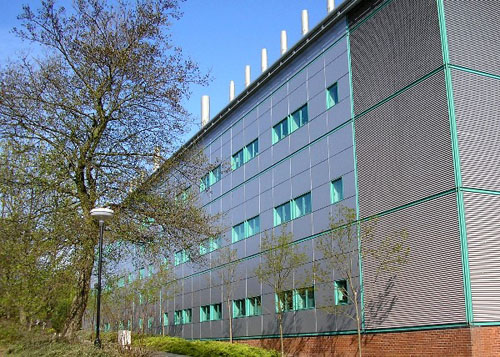THE STYLE and variety of Glasgow’s architecture in the decades after the Second World War is celebrated in a new book.
The book Glasgow’s Post-war Listed Buildings is a partnership between Historic Scotland and Glasgow City Council. There are 38 post-war listed buildings in Glasgow considered to be of national, regional or local importance.
Historic Scotland Head of Listing, Elizabeth McCrone said: “Glasgow is an incredible city that manages to mix different styles and periods of architecture in such a way that reflects all the social and economic changes throughout the centuries.
The Joseph Black buliding of Glasgow University is one of the listed buildings. Photo: Kay Williams
“Some of the buildings featured in this book were commissioned before the war but were delayed when fighting broke out. Others demonstrate the reaction against austerity following the end of war and rationing, with detailing and flourishes that simply wouldn’t have been designed previously.
“Many of these buildings sit as a cornerstone to their communities, they reflect the particular time and purpose behind their creation and I am delighted that we have been able to work with Glasgow City Council to recognise this.”
Bailie Liz Cameron said: “This wonderful collaboration between Glasgow City Council and Historic Scotland has resulted in this book and hopefully, in the future will result in many more collaborative projects.
“Glasgow has such a wonderful heritage; we are all familiar with the city’s beautiful Victorian Buildings and the value of this book is that it will now raise our awareness and appreciation of the quality of our more modern built heritage.”
The first lists of buildings of special architectural or historic interest in Glasgow were compiled in the late 1960s and early 1970s. In the 1980s all of its building stock was comprehensively resurveyed and at this time many of the prominent Victorian and Edwardian buildings were added to the lists, along with a handful of outstanding interwar buildings – many of which were begun before the Second World War and not completed until afterward.
Unsurprisingly, it was not possible to recognise the best post-war buildings a mere decade or so after they were first erected, therefore an understanding of them has been built up gradually. In the mid-1990s, with the benefit of growing research into this area of study, post-war buildings have been suggested to Historic Scotland as individual listing proposals, or have been listed following reviews of the work of well-known architects, such as the practice of Gillespie, Kidd and Coia, or Sir Basil Spence and more recently as part of the reviews of significant estates such as the University of Glasgow and the University of Strathclyde.
There are 38 post-war listed buildings inGlasgow, which is almost one fifth of the national total of post-war listed buildings.
Gillespie Kidd and Coia are represented most in the post-war listed buildings currently found in Glasgow with 9 buildings included on the lists. Thomas Cordiner is the second most represented with 5 listed buildings. Both these practices worked extensively for the Glasgow Diocese and many of their listed buildings are churches.
The earliest listing of a post-war building in Glasgow dates to 1989.
